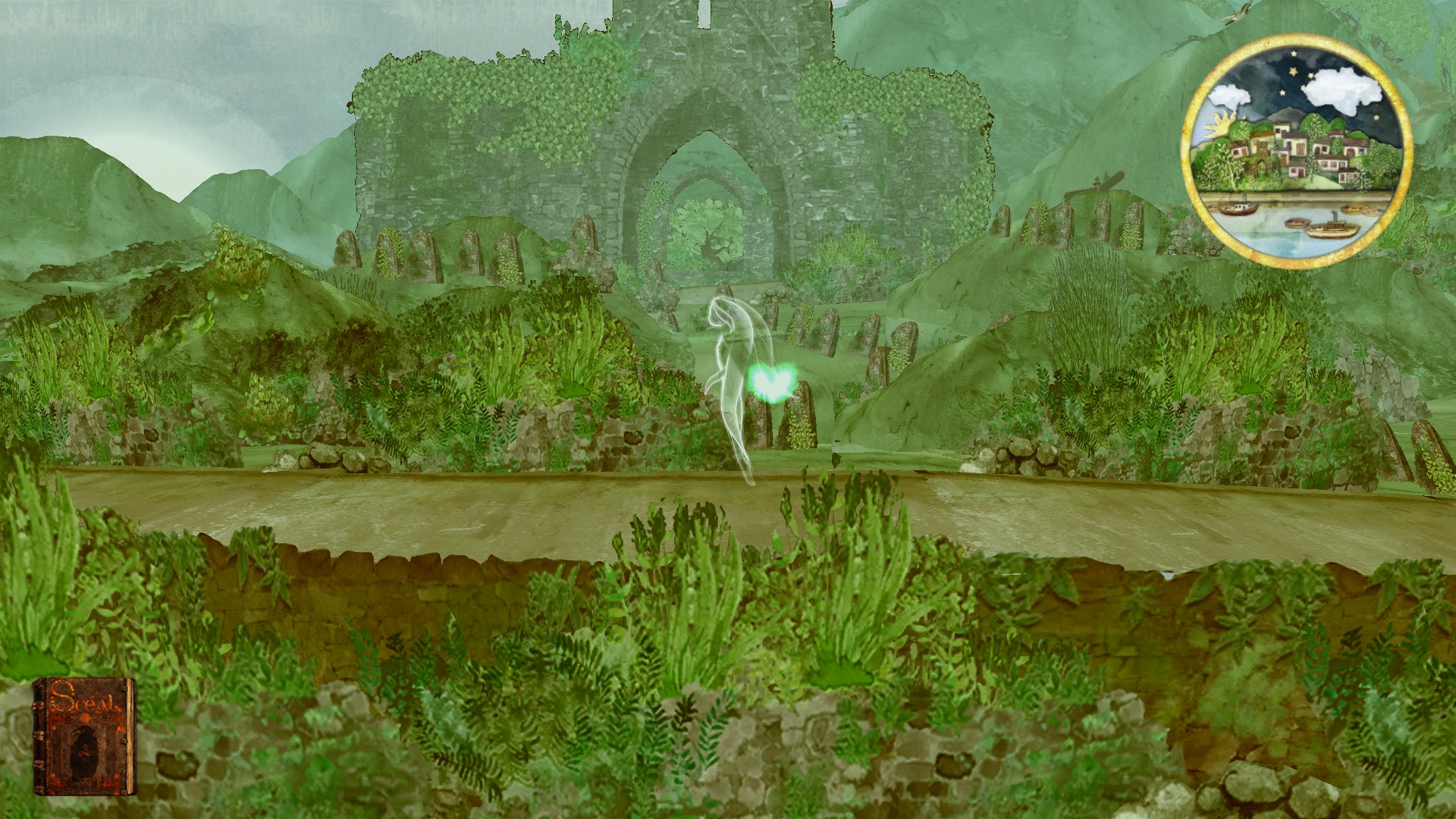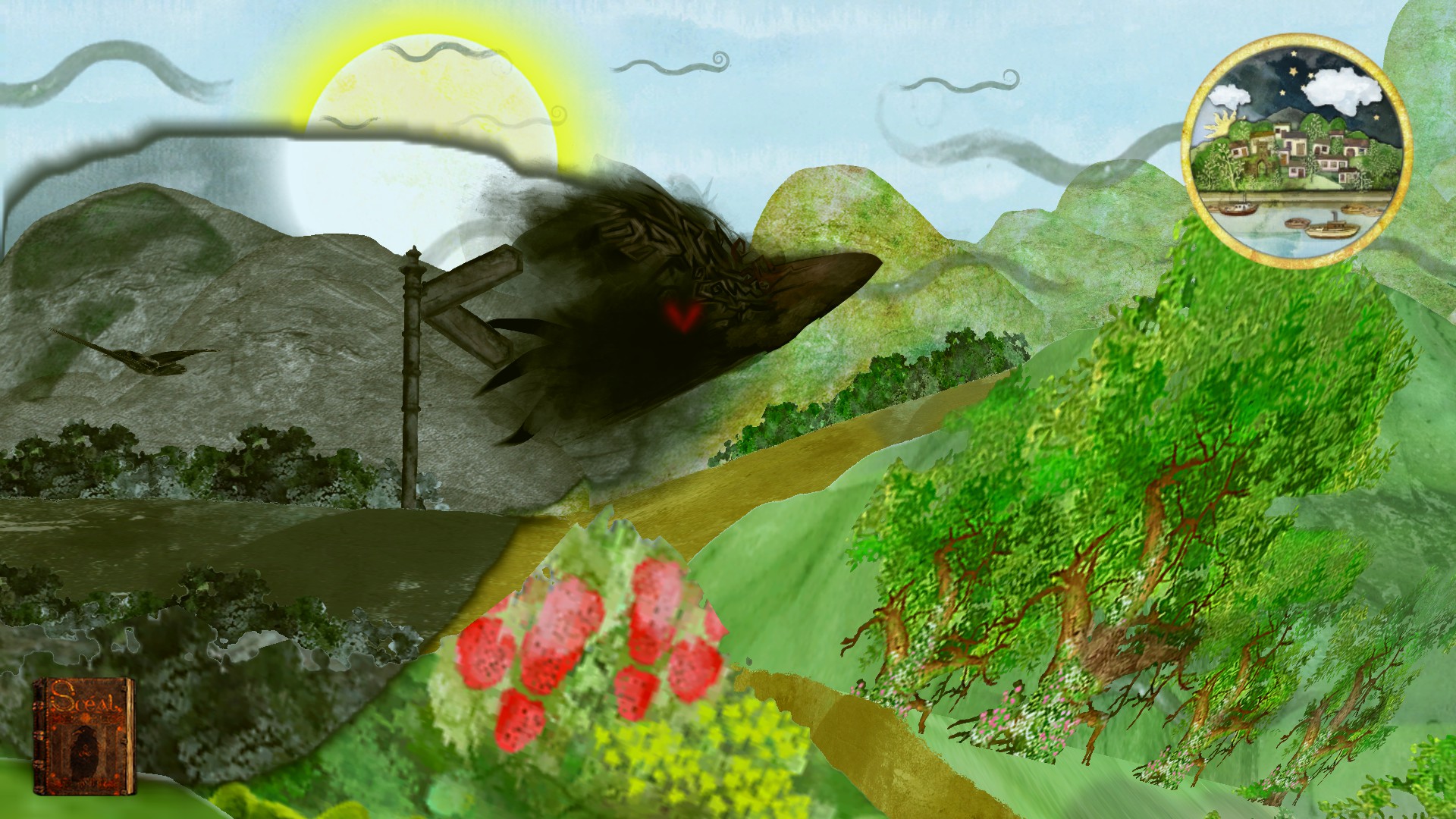Search
[{{{type}}}] {{{reason}}}
{{/data.error.root_cause}}{{{_source.title}}} {{#_source.showPrice}} {{{_source.displayPrice}}} {{/_source.showPrice}}
{{#_source.showLink}} {{/_source.showLink}} {{#_source.showDate}}{{{_source.displayDate}}}
{{/_source.showDate}}{{{_source.description}}}
{{#_source.additionalInfo}}{{#_source.additionalFields}} {{#title}} {{{label}}}: {{{title}}} {{/title}} {{/_source.additionalFields}}
{{/_source.additionalInfo}}- Details
- Category: Computer
- By Hannah Mae
- Hits: 5723
Scéal (PC)

Scéal
Developed By: Joint Custody
Published By: Joint Custody
Released: October 27, 2016
Available On: Windows
Genre: Adventure, Indie, Casual
ESRB Rating: Not Rated
Number of Players: Singleplayer
Price: $4.99 on Steam
Big thanks to Joint Custody for sending in their game!
What is Scéal? In Irish Gaelic, the word itself means 'story', and to Sandro Magliocco from Joint Custody it's a means to emote his childhood memories. Inspired by Celtic fueled films like The Secret of Kells, he wanted to recapture the quaint charms of an Irish village much like the one he grew up in, and with his team's support he set out to do just that in video game form. Released in 2016 on Steam, Sandro's pet project set out to carry us away to the Emerald Isle, but are there more than Celtic knots to mangle God's Truth?
You start the game, and an old book opens to begin its tale. You play as a young girl who has died - quite recently in fact. Problem is, you don't know how you died, who you were, nor where you lived. To make it worse, you have to know this stuff in order to enter the afterlife, which is kind of difficult when your'e an amnesiac. Thankfully, the guardian of the dead, a crow called Branna, has a solution. It presents to you an enchanted book that you must re-paint, and inside are hidden three magic feathers. Find the feathers, and you'll find your memories. Then and only then will you pass on.
At first glance, the story sounds interesting and is hyped up as the game's focus. It's even in the title for pity's sake. The way it's told in rhyme is nice if occasionally forced. Unfortunately, what's being told is anything but epic. This tale is as basic as you can get with nothing remotely unique about it at all. True, there are three possible endings to add variety, but these finishers left me un-entertained and confused. Two out of the three made absolutely no sense, and the real kicker is that the downer ending was the logical one. Now, don't misread me. For the most part, the story itself is passable. By no means is it a catastrophe, but for a plot that is touted as a big selling point, it's nowhere close to meeting the lofty expectations they garnered. The story isn't bad. It's just nothing special.

Strong Points: Pleasant visuals; Music captures the Irish vibe
Weak Points: Simplistic Story; Unengaging Gameplay
Moral Warnings: Magic Windstones; Mixed-up Portrayal of the Afterlife and the spiritual world in general
Scéal's structure is divided into three chapters. You might think that isn't much, and you'd be correct. You could beat a single chapter in under five minutes, and each one carries the same basic pattern: paint buildings, find villager, paint designated objects, pick up feather. That's pretty much it. The last chapter does alter the cycle a little but not enough to write about. Now, being a short game with a simple structure isn't a bad thing in itself. Brief runtimes are prone to high replay-ability, but Scéal's preset tasks make reruns an unrewarding rehash. If the developers thought to randomize feather locations, buildings to paint, or even just let you paint whatever you wanted it could have fixed the problem and strengthened the need to explore. Unfortunately, this isn't the case, so Scéal is more like an actual book than an interactive game in that regard. (Also, there are no save files, so you'll have to finish the entire game if someone else wants a turn.)
The controls are pretty straightforward. Click, hold, and point your mouse in the direction you want to go and scrub your brush back and forth to paint/change objects. Sounds simple, right? Well, sort of. At times, I had to click and re-click to get the ghost to listen, especially when switching paths or going uphill. Apparently, being able to float doesn't make you very mobile. Additionally, Scéal goes overboard in telling you what to do. There's no real invitation to look around for yourself. They spell out where the hidden items are, spoiling the idea of 'searching,' and clouded buildings are tagged with obvious icons, as if the fog covering wasn't already a giveaway. I also don't know why the developers bothered to call swiping at fog 'painting.' You can clearly see the building's actual colors underneath, so it's more like wiping frost off of your windshield than adding color. It shouldn't be that big of a deal, but similar to my complaints about the story, the advertising wasn't accurate. If they say I'm gonna paint, I should feel like I'm painting. On a similar note, there are two occasions where your little ghost transforms into either an angel or a banshee. You'll then be asked to either brighten or darken the environment around you, but your actions don't differ from the usual fare. You just rinse and repeat. Later on, you possess a villager (more on that nugget later), but all this involves is double clicking a person and walking around. It's obvious that this game didn't intend to be a challenge, and that's okay. I just wish the kinks were smoothed out, and they didn't treat the players like idiots.
Story, structure, and gameplay may be subpar, but I cannot deny the effort put in Scéal's presentation. The visuals capitalize on Irish artworks' emphasis for crowded yet finely blended details, but then the creators at Joint Custody took it a step further. First, they accomplished the storybook feel with flat structures that pop up whenever you're nearby. Second, they allowed the art to breathe by having the scenery change around you. As an angel, you bathe the world in sunshine, and summer blooms. As a banshee, villagers flee from your cold shadow, and winter dries the plants in greyscale. They even included night and day cycles with transitions to boot. That meant the artists had to paint Scéal's world no less than nine times! Now that's a feat! I paused often just to sit back and drink it all in. Our ghost's fluid movements and alternate forms were lovely too. For music, professional Irish musicians recorded Scéal's score in Dublin, and their tunes, often sung in Gaelic, were pleasing to the ear. The only presentational nitpicks I have are that the villagers' walk cycles looked a bit unnatural, and there were awkward pauses between music cycles. I may not have enjoyed playing Scéal, but I loved being in it.

Higher is better
(10/10 is perfect)
Game Score - 64%
Gameplay - 10/20
Graphics - 8/10
Sound - 8/10
Stability - 3/5
Controls - 3/5
Morality Score - 85%
Violence - 10/10
Language - 10/10
Sexual Content - 10/10
Occult/Supernatural - 4.5/10
Cultural/Moral/Ethical - 8/10
Sadly, I did stumble upon some technical difficulties. I first tried it on a laptop: with the basic requirements, and it started off really choppy. I resorted to the lowest resolution and had the game windowed just to get it to playable conditions. If you have a stronger system than mine, I'm certain you won't have a problem. On a side note, there were a couple times the villager AI malfunctioned. One got caught in a road sign twice, and several others, while straining to follow my lead, began rapidly flipping directions in some jerky dance. It was indeed hilarious but needs a tuneup. Lastly, Scéal's biggest programming blunder were the three times the camera zoomed in too close to a church for me to paint. This hiccup was so major it forced me to quit the game and restart. I guess that one slipped past quality control.
To discuss Scéal's moral integrity is tricky. On the one hand, it's upfront about its intent to showcase Irish customs and folklore. Thus, no Christian should be surprised by its inaccurate portrayal of the spiritual realm. I then considered Scéal's possible use as a teaching tool for mythology classes, but after investigating, I found very few similarities between its elements and actual recorded myth. However, educational or not, there are spots where I take serious issue. For one thing, this game fell into the basic 'follow your heart' trap. Then it had you answer a woman's prayers by restoring magic wind stones, and when you, the dead person, possess a living human it's treated as a good thing. Worst still is the implication that the nightmarish banshee isn't an evil creature as it's traditionally depicted. It's not that I don't believe God can and does use evil according to His perfect will for the ultimate good. It's the fact that the hellish banshee is presented as a fully aware agent for good that I've got a beef with.
In conclusion, I'm conflicted over Scéal. Half of it I liked. Half of it I didn't like. My judgments on the game itself were only further complicated thanks to Joint Custody's misplaced advertising. Due to Scéal's unimpressive narrative, lackluster gameplay, and short campaign, it felt as flat as their backgrounds. Yet because of its beautiful art style and gentle music, I can't call it a total waste. A a result, Scéal is comparable to a bedtime story. It's a diversion for tired minds and not intended to be psychoanalyzed. Within its mindless tasks, Sandro Magliocco did capture those relaxing Irish vibes. However, I'm still uncomfortable with letting an impressionable child into its morally mixed up pages. If you're seeking a sweeping narrative or a test of skill, move along; there's nothing for you here. But if you want to indulge your Celtic thirst, this could suffice. Otherwise, Scéal is more or less an ornamental goblet. It's lovely to see but ultimately hollow.








